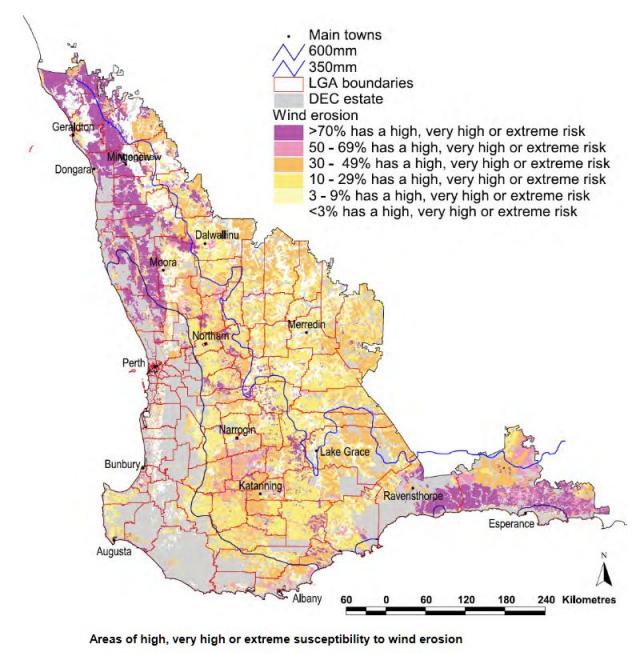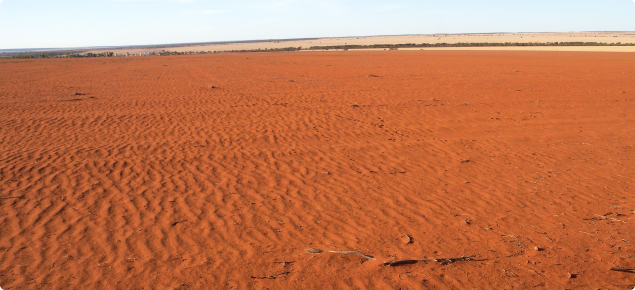Why south-west agriculture is particularly susceptible to wind erosion
The south-west of Western Australia (WA) has a Mediterranean climate (hot dry summers and cool wet winters) which largely favours annual broadacre cropping, ancient sandy surfaced soils, and erosive winds during the driest times of the year. Each of these factors contribute to WA's susceptibility to wind erosion.
Climate variability plays an important role in predisposing whole landscapes to wind erosion. In dry seasons, there can be significant areas of poor pasture and crop production, which provide less than adequate ground cover over the dry summer.
Climate change in south-west Western Australia is expressed as lower rainfall, higher temperatures, and later starts to the growing season. These factors increase the risk of wind erosion. See Climate trends in WA and Climate projections for WA for more detail.
Status and trend of wind erosion in the agricultural areas of Western Australia (WA)
- Wind erosion is a seasonal hazard in the south-west of WA.
- The indicator used for wind erosion hazard is erodibility – the potential for soil loss in erosive winds.
- More than half of the agricultural land had unacceptable hazard ratings (were below target values) at least one year in four during the period 2009–12.
- The Central Northern Wheatbelt Ag Soil Zone had the greatest hazard, with the zone being below target values in each of the four years 2009–12.
- Wind erosion hazard at the state level has reduced over time because of changed cropping and stubble management practices.
Management implications
- Current land use practices still result in some degree of wind erosion, with an estimated cost of $50–71 million per year.
- Increasing the use of stable ground cover (including living and dead vegetation and gravels) to prevent loss of soil, fine particles, nutrients and soil organic carbon is a practical and profitable option.
- Climate variability and a drying climate will increase the risk of wind erosion in the current agricultural system.
Conditions needed for wind erosion to occur
For wind erosion to occur, three conditions need to be met:
- an erodible soil surface – disturbed or detached soil with few obstructions
- an exposed soil surface – wind must be able to reach the soil surface
- erosive winds – wind speeds of greater than 28 kilometres per hour are needed to move soil particles and lift dust for significant distances.
In the agricultural areas and farming practices of south-west Western Australia, all three conditions are met at some times in some places each year.
WA soils and the impact of wind erosion
Western Australian soils generally have low inherent soil fertility and high susceptibility to wind erosion. We have estimated that 6.4 million hectares (ha) of agricultural land in WA is at risk of wind erosion – 0.02 million ha at extreme risk, 0.9 million ha at very high risk and 5.5 million ha at high risk (Figure 1).

Many WA soils have a sandy surface with limited finer fractions. Wind erosion removes the finer fractions from the soil, which includes the clay, organic matter and soil nutrients. The loss of these particles reduces the water and nutrient holding capacity of the soil and hence soil fertility.
For every 3% of the nitrogen that is removed from the soil, there is a 2% loss in yield of the following crop. If the top 10mm of soil are subjected to winnowing by the wind, crop yields may be reduced by 25%.
Additional fertiliser applications will increase the soil fertility, but the soil may not return to its original productivity, because of the loss of smaller particles which retain most of the nutrients. Other on-site impacts include the deposition of sand on fence lines and in waterways and dams. This requires time and resources to remove.
Managing wind erosion in Western Australia
There are technologies and management systems that can reduce or prevent the risk of wind erosion, and to stabilise and rehabilitate eroded areas. See Managing wind erosion in southern Western Australia for more details.
Resource condition target for wind erosion
Note that these targets and the likelihood ratings do not indicate actual wind erosion – they estimate the likelihood of erosion if erosive winds occur.
We have six ratings of erosion likelihood of a site, and group these as either 'acceptable' or 'unacceptable' (Table1).
| Rating | Physical characteristics | Likelihood class |
|---|---|---|
| Safe | No wind erosion likely and ground surface unlikely to be affected. | Acceptable |
| Negligible | Wind erosion unlikely although some minor dust is possible. Ground surface likely to remain intact. | Acceptable |
| Low | Dust and minor soil movement is likely although ground surface will probably remain unchanged. | Acceptable |
| Moderate | Dust and some sand movement and the start of ground surface particle sorting likely. | Unacceptable |
| High | Widespread dust and soil movement and rippling of ground surface likely. | Unacceptable |
| Very high | Widespread dust and sand movement and deep deflation (hollowing out) of soil surface likely. | Unacceptable |
For the long-term sustainability of the soil resource, we consider that less than 5% of the landscape should be in the unacceptable likelihood class each year, with the aspirational aim of less than 3% of the landscape being in an unacceptable likelihood class (Table 2).
| Target | Hazard | Criteria |
|---|---|---|
| Above target | Very low | <1% of the landscape in an unacceptable likelihood class |
| Above target | Low | 1–3% of the landscape in an unacceptable likelihood class |
| Above target | Moderate | 3–5% of the landscape in an unacceptable likelihood class |
| Below target | High | 5–10% of the landscape in an unacceptable likelihood class |
| Below target | Very high | >10% of the landscape in an unacceptable likelihood class |
Reading
Department of Agriculture and Food 2013, Report card on sustainable natural resource use in agriculture: Wind erosion, Department of Agriculture and Food, Western Australia
Department of Agriculture and Food, Western Australia 2014, Investing in sustainable resource use – reference metrics: a companion to the Report card on sustainable natural resource use in agriculture, Department of Agriculture and Food, Western Australia, Perth.
van Gool, D, Vernon, l & Runge, W, 2008, Land resources in the South-West Agricultural Region: a shire-based summary of land degradation and land capability, Resource Management Technical Report 330, Department of Agriculture and Food, Western Australia.


